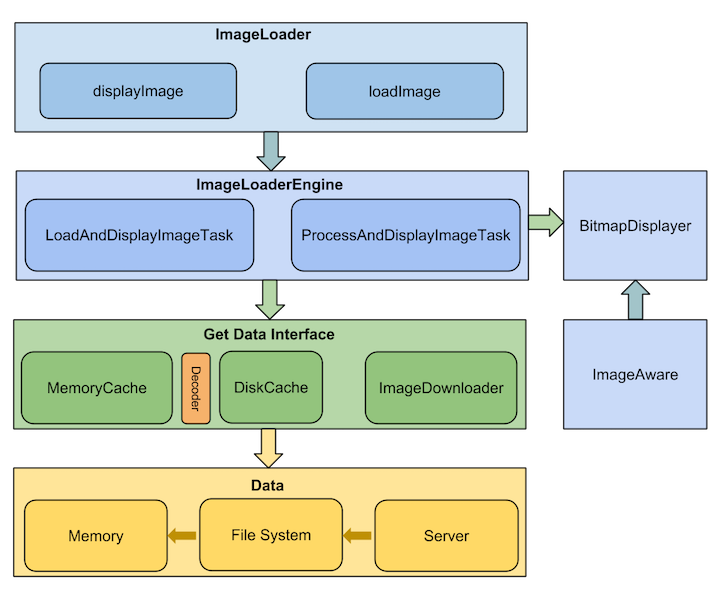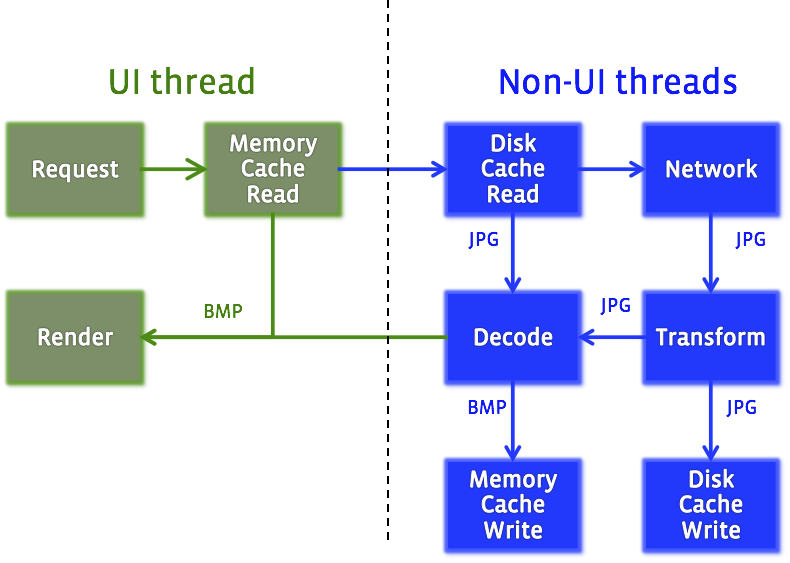Android图片加载库的理解
前言
内容目录
- ImageLoader设计原理
- ImageLoader流程图
- ImageLoader的使用
- ImageLoader优化
- Fresco介绍
- 图片策略优化
- 小结
ImageLoader设计原理
ImageLoader的工作原理:在显示图片的时,它会先在内存中查找,如果没有就去本地查找,如果还没有,就开一个新的线程去下载这张图片,下载成功会把图片同时缓存在内存和本地。

ImageLoader流程图

ImageLoader的使用
- ImagaLoaderConfiguaration——对图片缓存进行总体配置,包含内存缓存的大小,本地缓存的大小和位置、日志、下载策略(FIFO还是LIFO)等。
- ImageLoader——一般使用displayImage来把URL对应的图片显示在ImageView上。
- DisplayImageOptions——在每个页面需要显示图片的地方,控制如何显示的细节,比如指定下载时的默认图、是否将缓存放到内存或本地磁盘。
从三者的协作关系上看,他们有点像厨房规定、厨师、客户个人口味之间的关系。ImageLoaderConfiguration就像是厨房里面的规定,每一个厨师要怎么着装,要怎么保持厨房的干净,这是针对每一个厨师都适用的规定,而且不允许个性化改变。ImageLoader就像是具体做菜的厨师,负责具体菜谱的制作。DisplayImageOptions就像每个客户的偏好,根据客户是重口味还是清淡,每一个imageLoader根据DisplayImageOptions的要求具体执行。
ImagaLoaderConfiguaration
// DON'T COPY THIS CODE TO YOUR PROJECT! This is just example of ALL options using.// See the sample project how to use ImageLoader correctly.File cacheDir =StorageUtils.getCacheDirectory(context); ImageLoaderConfiguration config =newImageLoaderConfiguration.Builder(context) .memoryCacheExtraOptions(480, 800) // default = device screen dimensions .diskCacheExtraOptions(480, 800, null) .taskExecutor(...) .taskExecutorForCachedImages(...) .threadPoolSize(3) // default .threadPriority(Thread.NORM_PRIORITY-2) // default .tasksProcessingOrder(QueueProcessingType.FIFO) // default .denyCacheImageMultipleSizesInMemory() .memoryCache(newLruMemoryCache(2*1024*1024)) .memoryCacheSize(2*1024*1024) .memoryCacheSizePercentage(13) // default .diskCache(newUnlimitedDiskCache(cacheDir)) // default .diskCacheSize(50*1024*1024) .diskCacheFileCount(100) .diskCacheFileNameGenerator(newHashCodeFileNameGenerator()) // default .imageDownloader(newBaseImageDownloader(context)) // default .imageDecoder(newBaseImageDecoder()) // default .defaultDisplayImageOptions(DisplayImageOptions.createSimple()) // default .writeDebugLogs() .build();
DisplayImageOptions
每一个ImageLoader.displayImage(...)都可以使用DisplayImageOptions,具体配置代码如下:
// DON'T COPY THIS CODE TO YOUR PROJECT! This is just example of ALL options using. // See the sample project how to use ImageLoader correctly. DisplayImageOptions options = new DisplayImageOptions.Builder() .showImageOnLoading(R.drawable.ic_stub) // resource or drawable .showImageForEmptyUri(R.drawable.ic_empty) // resource or drawable .showImageOnFail(R.drawable.ic_error) // resource or drawable .resetViewBeforeLoading(false) // default .delayBeforeLoading(1000) .cacheInMemory(false) // default .cacheOnDisk(false) // default .preProcessor(...) .postProcessor(...) .extraForDownloader(...) .considerExifParams(false) // default .imageScaleType(ImageScaleType.IN_SAMPLE_POWER_OF_2) // default .bitmapConfig(Bitmap.Config.ARGB_8888) // default .decodingOptions(...) .displayer(new SimpleBitmapDisplayer()) // default .handler(new Handler()) // default .build();
ImageLoader
ImageLoader imageLoader = ImageLoader.getInstance(); // Get singleton instance // Load image, decode it to Bitmap and display Bitmap in ImageView (or any other view // which implements ImageAware interface) imageLoader.displayImage(imageUri, imageView);
// Load image, decode it to Bitmap and return Bitmap to callback imageLoader.loadImage(imageUri, new SimpleImageLoadingListener() { @Override public void onLoadingComplete(String imageUri, View view, Bitmap loadedImage) { // Do whatever you want with Bitmap } });
ImageLoader优化
protected void onDestroy() { //回收该页面缓存在内存的图片 imageLoader.clearMemoryCache(); super.onDestroy(); }
Fresco介绍
Fresco 是一个强大的图片加载组件。它是Facebook开源的图片加载库
Fresco 中设计有一个叫做 image pipeline 的模块。它负责从网络,从本地文件系统,本地资源加载图片。为了最大限度节省空间和CPU时间,它含有3级缓存设计(2级内存,1级文件)。
Fresco 中设计有一个叫做 Drawees 模块,方便地显示loading图,当图片不再显示在屏幕上时,及时地释放内存和空间占用。
Fresco 支持 Android2.3(API level 9) 及其以上系统。

为了下载网络图片,请确保在 AndroidManifest.xml 中有以下权限:
<uses-permission android:name="android.permission.INTERNET"/>
在 Application 初始化时,在应用调用 setContentView() 之前,进行初始化:
Fresco.initialize(context);
在xml布局文件中, 加入命名空间:
<!-- 其他元素 --> <LinearLayout xmlns:android="http://schemas.android.com/apk/res/android" xmlns:fresco="http://schemas.android.com/apk/res-auto"> 加入SimpleDraweeView: <com.facebook.drawee.view.SimpleDraweeView android:id="@+id/my_image_view" android:layout_width="20dp" android:layout_height="20dp" fresco:placeholderImage="@drawable/my_drawable" />
开始加载图片
Uri uri = Uri.parse("https://raw.githubusercontent.com/facebook/fresco/gh-pages/static/fresco-logo.png");
SimpleDraweeView draweeView = (SimpleDraweeView) findViewById(R.id.my_image_view);
draweeView.setImageURI(uri);
图片策略优化
- 要确保下载的每张图,都符合ImageView控件的大小。可以事先准备很多套不同的分辨率的图片,然后每次根据URL请求图片时,都要额外在URL上加两个参数,width和height,从而要求服务器返回其中某一个张图,比如:http://www.aaa.com/a.png?width=100&height=50
- 低流量模式。在2G和3G网络环境下,我们应该适当降低图片的质量,降低图片质量,相应的图片大小也会降低,简称低流量模式,比如在请求网址中再添加一个参数,叫做quality,在2G网络下这个值为50%,在3G网络情况下,这个值为70%,这样就会将JPG图片质量降低为50%或70%。
- 极速模式。发现在2G和3G网络环境下,大部分用户对图片不感兴趣,我们可以设计一些只有文字的页面,这种页面称呼为极速模式,以节省流量。
小结
本篇主要介绍了第三方图片加载库的原理和使用方法,特别是ImageLoader的介绍,因为图片显示在APP中是很常见的应用场景,况且ImageLoader已经封装好了一些类和方法。我们可以直接拿来用了。而不用重复去写了。如果自己去写一个的话,这方面的程序还是比较麻烦的,要考虑多线程缓存,内存溢出等很多方面,再说这么多程序都在用,说明稳定性还是可靠的,类似这种工具类能用稳定成熟的,我们作为一名开发人员,专注度还是在应用业务开发上。





【推荐】国内首个AI IDE,深度理解中文开发场景,立即下载体验Trae
【推荐】编程新体验,更懂你的AI,立即体验豆包MarsCode编程助手
【推荐】抖音旗下AI助手豆包,你的智能百科全书,全免费不限次数
【推荐】轻量又高性能的 SSH 工具 IShell:AI 加持,快人一步
· AI与.NET技术实操系列:向量存储与相似性搜索在 .NET 中的实现
· 基于Microsoft.Extensions.AI核心库实现RAG应用
· Linux系列:如何用heaptrack跟踪.NET程序的非托管内存泄露
· 开发者必知的日志记录最佳实践
· SQL Server 2025 AI相关能力初探
· winform 绘制太阳,地球,月球 运作规律
· AI与.NET技术实操系列(五):向量存储与相似性搜索在 .NET 中的实现
· 超详细:普通电脑也行Windows部署deepseek R1训练数据并当服务器共享给他人
· 【硬核科普】Trae如何「偷看」你的代码?零基础破解AI编程运行原理
· 上周热点回顾(3.3-3.9)